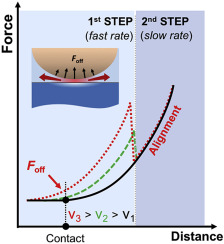Polymer ( IF 4.1 ) Pub Date : 2018-01-08 , DOI: 10.1016/j.polymer.2018.01.017 Rok Simič , Christian H. Mathis , Nicholas D. Spencer

|
Soft, biphasic materials such as hydrogels are commonly used to mimic lubrication and confinement mechanics of biological tissue such as articular cartilage or the cornea. In-depth understanding of such mechanics is crucial for designing synthetic replacements for cartilage, contact-lens materials or soft coatings for medical devices. Using colloidal-probe atomic force microscopy (AFM), surfaces can be investigated at the nanoscale and information on the contact modulus, poro-viscoelastic properties and the permeability can be extracted. Yet, probing the surface of a soft material in a liquid environment is challenging, since the point of contact between a probe and sample surface during finite-rate indentation can be obscured by viscous squeeze-out effects of temporarily confined liquid. To address this issue, we have developed a 2-step indentation method that enables accurate alignment of finite-rate indentation curves with respect to the contact point of quasi-static indentation of soft matter in liquid. In this work, the issue and the method are illustrated by measurements on a commonly used poly(acrylamide) (PAAm) hydrogel. We have shown that liquid squeeze-out may cause non-negligible force offsets that can result in false contact-point determination during finite-rate indentation. The presented method allows accurate alignment of the indentation curves, enables one to accurately study the rate-dependent contact moduli and related stiffening effects, and thus greatly facilitates mechanical characterization of both biological as well as synthetic soft materials.
中文翻译:

水凝胶速率依赖性纳米压痕的两步法
柔软的两相材料(例如水凝胶)通常用于模拟生物组织(例如关节软骨或角膜)的润滑和封闭机制。对于设计用于医疗设备的软骨,隐形眼镜材料或软涂层的合成替代品,深入了解此类力学至关重要。使用胶体探针原子力显微镜(AFM),可以在纳米级研究表面,并可以提取有关接触模量,孔隙粘弹性和渗透率的信息。然而,在液态环境中探测柔软材料的表面具有挑战性,因为在有限速率压入过程中,探针和样品表面之间的接触点可能会因暂时密闭液体的粘性挤出作用而被掩盖。为了解决这个问题,我们已经开发出一种两步压痕方法,该方法可以使有限速率压痕曲线相对于液体中软质准静态压痕的接触点精确对齐。在这项工作中,通过在常用的聚丙烯酰胺(PAAm)水凝胶上进行测量来说明问题和方法。我们已经表明,液体挤出可能会导致不可忽略的力偏移,这会导致在有限速率压痕过程中错误地确定接触点。所提出的方法允许压痕曲线的精确对准,使人们能够精确地研究速率相关的接触模量和相关的刚性效应,从而极大地促进了生物以及合成软材料的机械表征。











































 京公网安备 11010802027423号
京公网安备 11010802027423号